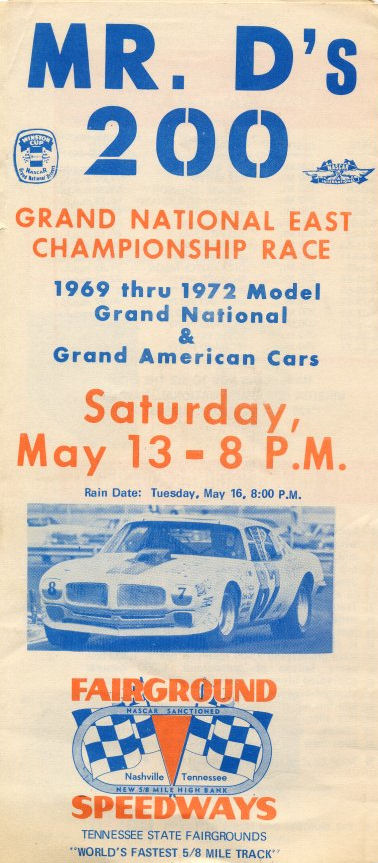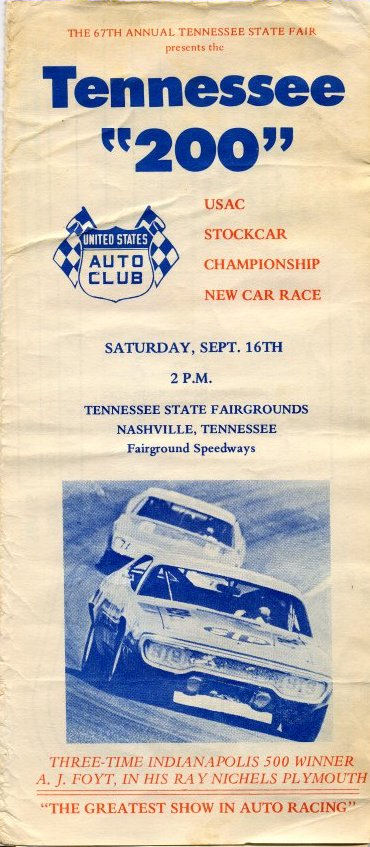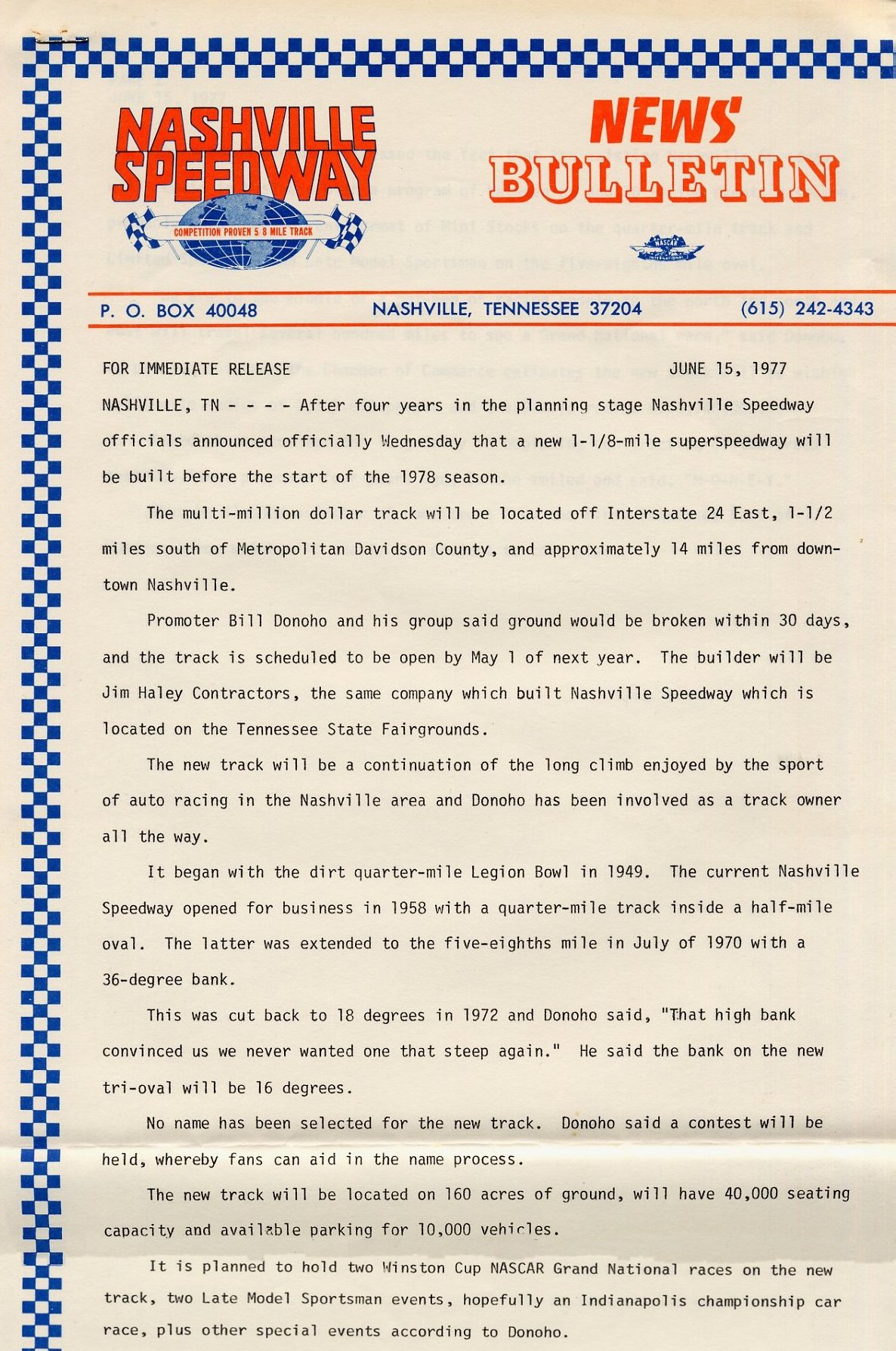I found a few more things to add.
This first brochure is for the Mr. D's 200. The Mr. D's 200 was a Grand National East race. The Grand National East division started in 1972, made up mostly of the short tracks that were dropped from the main Grand National schedule when Winston demanded the schedule be cut from fifty-plus races down to 30 races of 250 miles or longer. The fields were comprised of both full-size Grand National (now Cup) cars and Grand American cars. This was the 5th race in the division's history.
Bobby Allison won the race driving a Ford Mustang while Elmo Langley was 2nd in his Ford GN car. NASCAR was so impressed with the size of the crowd and the professionalism in which the track ran the event, Nashville was awarded a second Cup race the following year, and the Music City 420 was added to the 1973 schedule. That event stayed on the schedule until NASCAR took both Cup dates away in March of 1985.
One other thing about the race sponsor. For those of you not up to speed on your seafood restaurant history, the first Mr. D's seafood restaurant was opened in Donelson, TN, in 1969. Not long after they sponsored this race, they changed their name to Captain D's.
Another unique race from the 1972 season was the Tennessee 200 USAC stock car race. USAC stands for United States Auto Club. They were the sanctioning body for the Indianapolis 500, but they also had a stock car division. They had competed at Nashville in 1959 and 1960, and in the sixties on a national level, the series was nearly an equal to NASCAR (which at the time was seen as more of a Southeastern regional sport). In the fifties, sixties, and even into the 70s, many drivers who competed in the Indianapolis 500 also competed in many of the USAC stock car races.
Although the brochure states AJ Foyt would be competing, he didn't make it to Nashville. But Indy stars Bobby Unser, Gordon Johncock, and Roger McCluskey were in the race along with the full-time USAC stock car stars.
But unknown to the USAC stars, there was an unknown ringer in the field. In September of 1972 Darrell Waltrip had raced in a total of four Winston Cup races. But he had three full years of experience on the 36-degree banks at Nashville. The Tennessee 200 was like throwing Br'er Rabbit in the briar patch. Running the same Terminal Transport Mercury he was running in the Cup series, Waltrip qualified on the pole, led all 200 laps, and lapped the field in the process.
Bobby Unser once told me he was driving as hard as he had ever driven, so tired he was about to fall out of the seat, and looked up and, "Here came Waltrip lapping me like I was tied. And waved as he went by!"
Unser finished second, one lap down, while Johncock was third, 4 laps down.
The USAC guys couldn't believe this kid they had never heard of had beaten them so badly. So they decided to tear the car apart during the post race inspection. The car was found legal in every area, and the USAC guys left scratching their heads with their tail between their legs.
I firmly believe that race helped put Waltrip's name on the national racing radar as much as anything he had done to that point in his career.
This is a press release dated June 15, 1977. You can click on it to enlarge it and read it, but it describes a new 1 1/8-mile Super Speedway to be built at what is now the Waldron Road exit off of I-24 near Lavergne.
When the current Nashville Superspeedway was announced in the late nineties, most of the old school racers in Nashville were skeptical to say the least. This 1977 announcement is only one of the reasons. Too many times through the years we had been told there was going to be a speedway built in the Nashville area. In June of 1968 it was announced that the track at the Fairgrounds would be the first 3/4-mile track built in the country, to be ready for the 1969 season. Hmm. I'd say that plan worked out pretty good for Richmond 20 years later.
I don't know if this is fact or urban legend, but the reason I've always heard this track was never built is because when construction started, they found the entire site was almost solid bedrock. The demolition costs would have put the project too far over the money available, so the project was scrapped.
These final two items were passed along by Rob Spires. One is a cool license plate the track produced for the 1976 Bicentennial season. You'd see LOTS of these on vehicles in the late 70s in the Middle Tennessee area.
These next items help show just how special the Nashville Fairgrounds Speedway is in the racing world. How many tracks that run just Saturday night races have had die-cast cars produced of cars that have raced there and have a track car of its own? Not being a die-cast collector I don't know the answer, but I'd venture to say few, if any other track.
Thanks for the contribution Rob! If anyone else has cool stuff to post, send it along.



COOL STUFF,RUSS....I LOVE IT,IT'S NEVER 2011 ON THIS BLOG,AND THATS A GOOD THING!..RUSS,KEEP IT UP YOUNG MAN ,AND I'LL LET YOU HAVE MY RC BOTTLE CAPS SO YOU CAN GO HAVE SOME FUN AT FAIRPARK!!
ReplyDeleteI remember those license plates all around town. I wanted my parents to put one on the front of our old 1969 Oldsmobile Delta 88. Sadly, they wouldn't agree to it. In retrospect, I sure wish I'd bought one for myself with my lawn mowing money.
ReplyDeleteI have a brochure from Nashville Fairground Speedways for August 1973. Do you want it? I can text you a picture, but i don't know how to send a picture here. 😒 (too tech challenged 😏)
ReplyDeleteMy # 706.830.3132 txt only
ReplyDelete